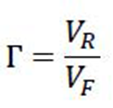- TOP
- > Technology column
- > VSWR and Return Loss Coefficient
 VSWR and Return Loss Coefficient
VSWR and Return Loss Coefficient
VSWR (Voltage Standing Wave Ratio) is an indicator of signal reflection characteristics in coaxial cables.
VSWR can be expressed as the ratio of the voltage amplitude (V) of the traveling wave (input signal) to the voltage amplitude (V) of the reflected wave (signal reflected back at the end of the cable).

Relationship between VSWR and return loss coefficient
The reflection coefficient Γ is defined as the ratio of the voltage amplitude (V) of the traveling wave (input signal) to the voltage amplitude (Vz) of the reflected wave (the signal reflected back at the cable’s terminus).

By rearranging the VSWR definition equation,

(|Γ| is the absolute value of the return loss coefficient Γ). From the above equation, VSWR approaches 1 as the reflected wave (V) becomes smaller, and becomes ∞ in the case of total return loss (V=VR).
VSWR is an important indicator in RF circuit design. Understanding VSWR enables the suppression of signal reflection and the realization of efficient transmission.
